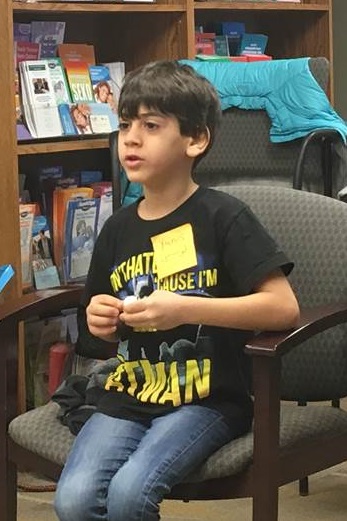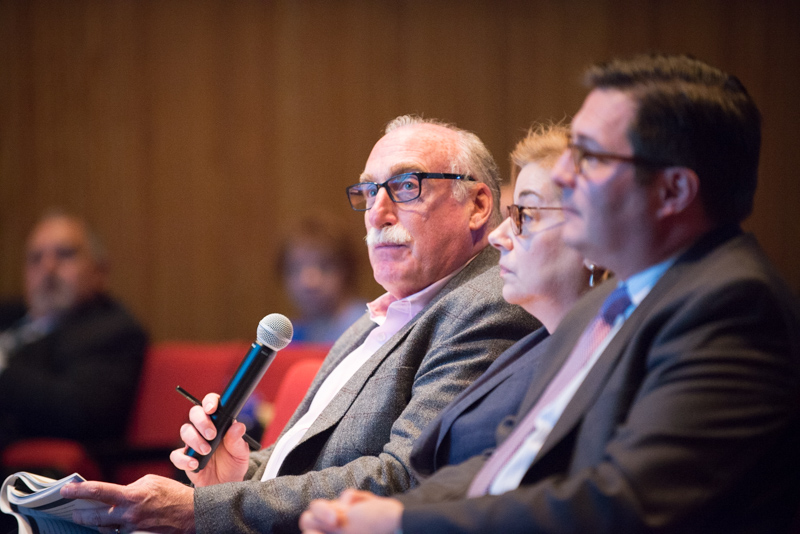In what has been described lightheartedly as a combination of the television shows “Shark Tank” and “The Voice,” graduating cohorts of Health Leadership Fellows present their final projects to a reactor panel and an audience of colleagues and community members at a graduation ceremony each year.
Fellows develop these inter-organizational projects focused on improving health care for young children and older adults over the course of an intensive 18-month program designed to build a network of skilled leaders.
At a ceremony in April 2018, teams from the seventh cohort of Health Leadership Fellows presented projects that tackled tough issues ranging from childhood obesity to mental health in older adults.
“Impacting Emotional Health: One County at a Time”
As we get older, physical illness and functional disability become more common, and may lead to a loss of autonomy, isolation, pain and depression. Add in factors such as poverty, lack of mental health providers and access to firearms and this can lead to an increased risk of suicide.
In Herkimer County, a rural county in central New York, the team found that white males over age 65 with a high school education were particularly vulnerable.
From 2013 to 2016, 12 men over the age of 65 in Herkimer County completed suicide. Of the 12 men who completed suicide, six completed suicide by gunshot.
Research shows that men are more reluctant to seek professional help when feeling depressed, hopeless or suicidal.
To help reduce suicide rates among older men in Herkimer County, the team worked with partners throughout the community, including primary care physicians, a Mobile Crisis Assessment Team, mental health providers, first responders, government agencies, employers, senior centers, libraries, restaurants, bars, churches, libraries and barbershops to offer suicide prevention training and promote suicide prevention and mental health resources specifically targeted to older men.
 This includes Man Therapy a web-based suicide prevention resource made especially for men. It was designed to address the “problematic thinking that says mental health disorders are unmanly signs of weakness.” The team distributed coffee sleeves and coasters to promote Man Therapy, along with information on how to connect to the local Mobile Crisis Assessment Team, to local bars, coffee shops, restaurants, stores and churches.
This includes Man Therapy a web-based suicide prevention resource made especially for men. It was designed to address the “problematic thinking that says mental health disorders are unmanly signs of weakness.” The team distributed coffee sleeves and coasters to promote Man Therapy, along with information on how to connect to the local Mobile Crisis Assessment Team, to local bars, coffee shops, restaurants, stores and churches.
The team also hosted two SafeTALK training sessions. SafeTALK (Tell, Ask, Listen, and KeepSafe) training demonstrates how to recognize individuals at risk of suicide and connect that person to intervention resources.
In addition, the team distributed 321 free gunlocks at two distribution events and three gun shops.
“When I went to Moose River Coffee Shop to deliver additional coasters and coffee cup sleeves, the staff there spoke about how happy they were to partner with us on this initiative. They know of at least one man whom they’ve been worried about, knowing that he needed to be connected with services, but not knowing how to go about broaching the subject,” Judith Reilly, services director, North Eastern Rescue Vehicles, said.
Breathing Buddies
 “Breathe in…..breathe out…..breathe in…..breathe out….” A soothing voice guided a small group of young children each clutching their own a little stuffed turtle – their “breathing buddy” – though a deep breathing exercise.
“Breathe in…..breathe out…..breathe in…..breathe out….” A soothing voice guided a small group of young children each clutching their own a little stuffed turtle – their “breathing buddy” – though a deep breathing exercise.
Teachers in two day care settings in Buffalo, NY used these deep breathing exercises as part of a pilot for Breathing Buddies, a program developed to improve coping and resiliency skills in children under age five.
Building resilience means that children are better able to manage their emotions and behaviors and bounce back from difficult or even traumatic experiences. Developing resiliency skills at a young age can benefit a child into adulthood, and help improve not only their mental, but physical health.
By training daycare providers to use the Breathing Buddies program, the goal was for children to develop socially acceptable self-management skills that they can use to manage stressful situations as they progress through school, as well as decrease inappropriate behaviors.
Providers received a resource toolkit to implement the program that included a detailed lesson plan, web-based app, breathing buddies (stuffed turtles) for their children and a form to track progress on five age-appropriate performance measures.
In the two-week pilot, 10 children under the age of five participated in a total of 20 Breathing Buddies session. Overall, the response was positive, and the daycare providers indicated that they would like to continue the program.
From Why Me to What’s Next: Changing Minds About Memory Impairment
As the U.S. population ages, the impact of Alzheimer’s disease and other dementias on the lives of older Americans will be one of the greatest health care challenges we face. Helping individuals diagnosed with memory impairment live with dignity and independence for as long as possible is critical.
With its “From Why Me to What’s Next” project, the team focused on early diagnosis, and how people are living with cognitive impairment.
However, even though early detection and diagnosis leads to better health outcomes, there is a lack of awareness, fear and stigma around memory impairment and dementia that prevents people from discussing symptoms with their doctor.
To reduce bias about memory impairment and change attitudes toward pursuing diagnosis, the team produced a video featuring Cynthia Huling Hummel, who is in the early stages of Alzheimer’s disease.
Cynthia tells her story about being diagnosed and how she lives with her disease, in the process dispelling common myths about memory impairment that individuals are not able to live independently, make decisions, learn new skills, be hopeful about the future or maintain a good quality of life.
In order to test whether the video was effective at changing people’s attitudes, the team distributed surveys to 95 people and asked to complete them before and after watching the video.
In the post survey, 76% of respondents said they feel more hopeful about memory impairment after watching the video, 40% said they might bring up a memory-related issue with their doctor or encourage a loved one to do so and 73% said that it might change the way they viewed a person living with memory impairment.
The team plans to identify ways to share this video more broadly with medical students, nursing students, health care professionals, those newly diagnosed with Alzheimer’s and the general public.
Dory in Crisis: Empathy vs. Ambulance
Gayle was an 85-year-old woman living in a skilled nursing facility. She had mild dementia, and was having episodes of erratic, explosive behavior. Each time, she was sent by ambulance to Erie County Medical Center, only to return to the nursing facility soon after. The cycle repeated. But then a nurse at the facility sat down with Gayle and her family and listened to them. The nurse discovered that Gayle had been raped as a young woman and the nursing home aide caring for her reminded her of her rapist. When that aide was removed from Gayle’s care, the episodes ceased.
When older adults living in adult care facilities become agitated, disoriented or even combative, they are often taken to the emergency room and then discharged back to the adult care facility without receiving any significant care, and left traumatized by the experience.
In fact, one-third of patients over 70 and more than half of patients over 85 leave the hospital more disabled than when they arrived, said Dr. Bruce Troen, director of the UB Center for Successful Aging.
Through this pilot project, the team worked to implement the Crisis Intervention Training model for nursing home staff at Niagara Lutheran Health Systems to change how staff thinks about and approaches older adults in order to de-escalate a situation and prevent unnecessary hospital visits.
Training, provided in collaboration with Crisis Services, included information on ageism, mental health and dementia, and gave staff tools to avoid or de-escalate a crisis with a resident.
Following the training, staff reported they were more comfortable dealing with a patient having a crisis, as well as their families. One staff member, a nurse who has been working in skilled nursing for 40 years, said that to “slow down, sit down, take time and talk” is a technique that is especially beneficial for younger employees to learn. Staff also noted the strong impact that the presentation on ageism had on them.
The team plans to duplicate this training model at other facilities, work with police departments to promote Crisis Intervention Training and engage the community in a discussion about ageism.
Early Engagement of Arabic-Speaking Families: Developing English Vocabulary Skills to Foster Healthy Behaviors
Though there are many resources available to individuals who migrate to the United States that can aid in their transition to America, economic, educational and health gaps often still exist. This includes children’s vocabulary development and reading proficiency, which can affect their school readiness, graduation rates, future employment and success in life.
Statistics show that children who are English Language Learners are more likely to struggle in school. According to the Children’s Literacy Foundation, one out of six children who do not read at age level by the end of third grade will not graduate from high school.
In WNY, the challenges faced by non-English speakers are illustrated by New York State Education Department’s Graduation Rate Data report, which indicates that only 27% of English Language Learner (ELL) students in Buffalo Public Schools graduated in 2017, compared to 67 percent of students whose primary language was English.
To encourage vocabulary development, the team designed a three-week educational program for 17 families at the Ken-Ton Family Support Center to empower young Arabic-speaking children and their families to increase their English vocabulary skills through fun, interactive activities focused on healthy behaviors.
For example, using a bilingual approach, one session focused on oral health activities and vocabulary in both English and Arabic, including how to properly brush your teeth. After learning new vocabulary, children practiced brushing their teeth with their parents.
By helping children, as well as in some cases, their parents, develop English language skills, this program “helps break through the barrier of isolation for these families,” Janet Cerra, coordinator of the Ken-Ton Family Support Center, said.
One mother shared how her son has improved. “I noticed a big difference with my son. He doesn’t interact with kids usually and doesn’t go to school. And now he’s the one who pushes me and tells me ‘let’s go,the bus is going to be here, I want to come here.’ So he’s very happy. At home he keeps repeating the vocabulary that he learns here.”
Moving forward, Cerra is committed to adopting the project design throughout the Ken-Ton School District.
Re-Think the Drink
Childhood obesity is a growing public health concern that has risen to epidemic proportions. While rising childhood obesity rates are a problem across the state and nation, research shows that rates are particularly high in Cattaraugus County. According to the 2016-2018 Olean General Hospital and Cattaraugus County Health Department Community Health Assessment, the obesity rate for children ages 2-19 in Cattaraugus County is 19.3 percent, compared to 17.3 percent in New York State and 17 percent nationwide.
 Although several factors can play a role, one factor that contributes to childhood obesity is the consumption of sugary beverages, which includes not only soda, but juice and other sweetened beverages. Each sugary drink a child has each day increases his or her risk for obesity by 60 percent.
Although several factors can play a role, one factor that contributes to childhood obesity is the consumption of sugary beverages, which includes not only soda, but juice and other sweetened beverages. Each sugary drink a child has each day increases his or her risk for obesity by 60 percent.
So to help cut down on kids’ consumption of sugary drinks, the team partnered with the Cattaraugus County Health Department and Project Head Start to implement “Re-Think the Drink,” a 4-week educational intervention directed at parents of Head Start students from four different Head Start locations in Cattaraugus County.
During this four-week period, the team provided four separate educational flyers that were sent home with the students in their backpacks for the parents, and posted them on the Head Start Facebook page.
Comparing pre-and post-surveys, parents’ knowledge and beliefs around sugary drink consumption, obesity, and long-term effects of obesity showed some significant changes. Data showed that parents decreased their children’s consumption of sugar sweetened beverages by 10 percent in the four-week time frame, which shows promise that weekly education can have some effect in changing behaviors.



